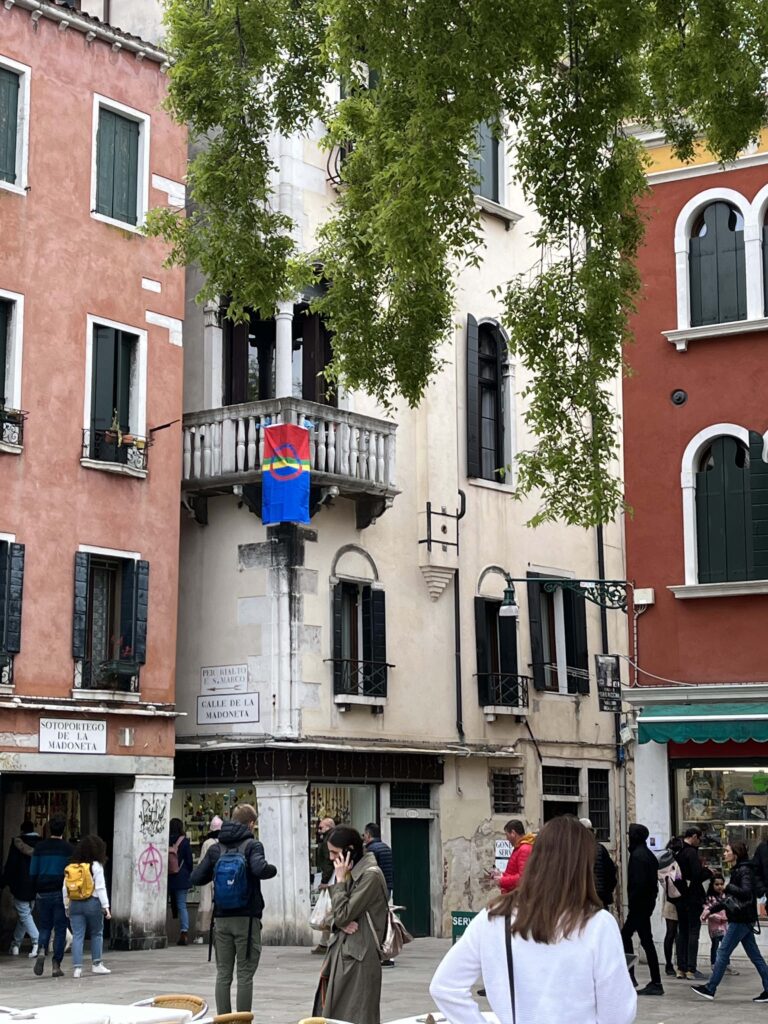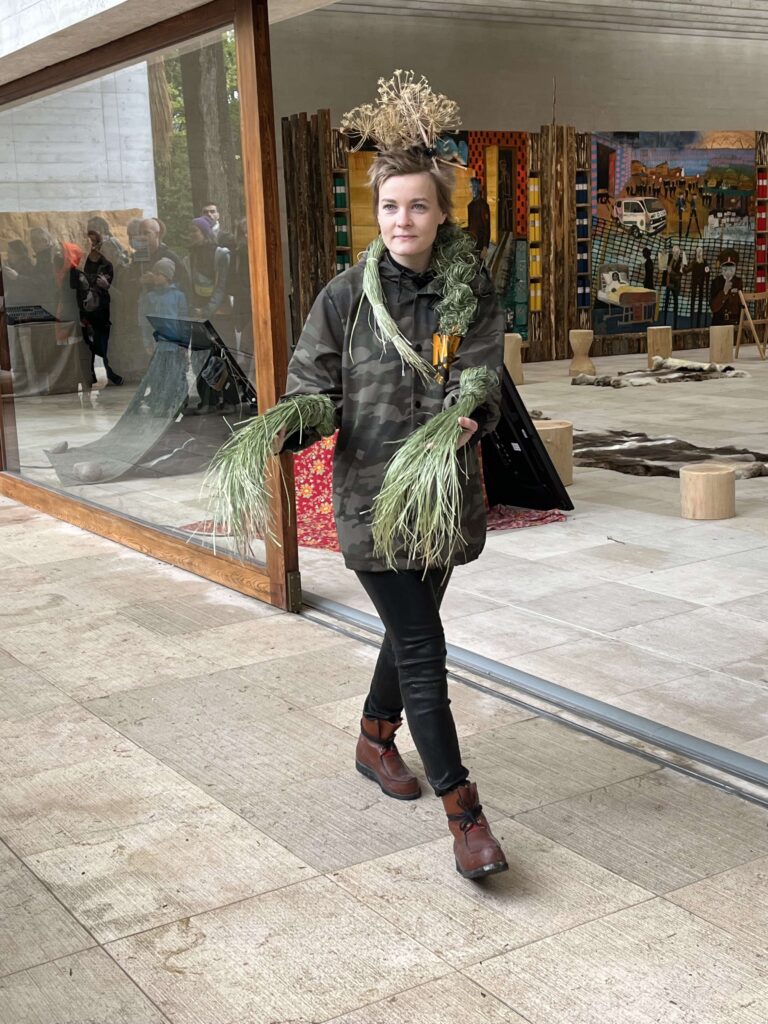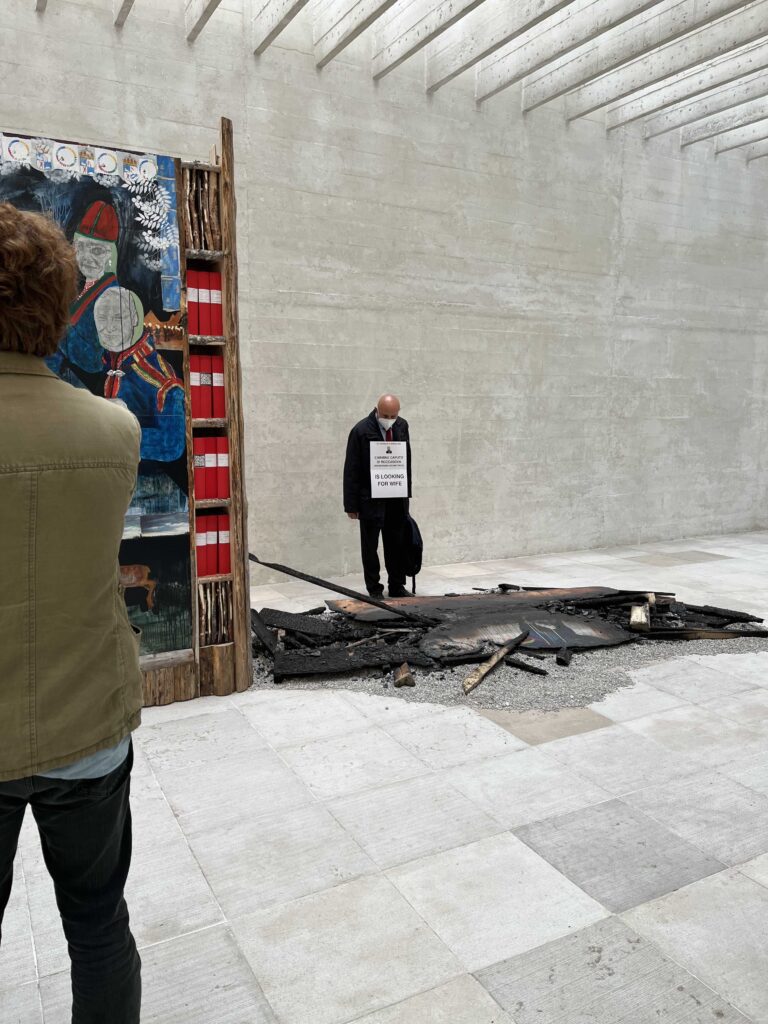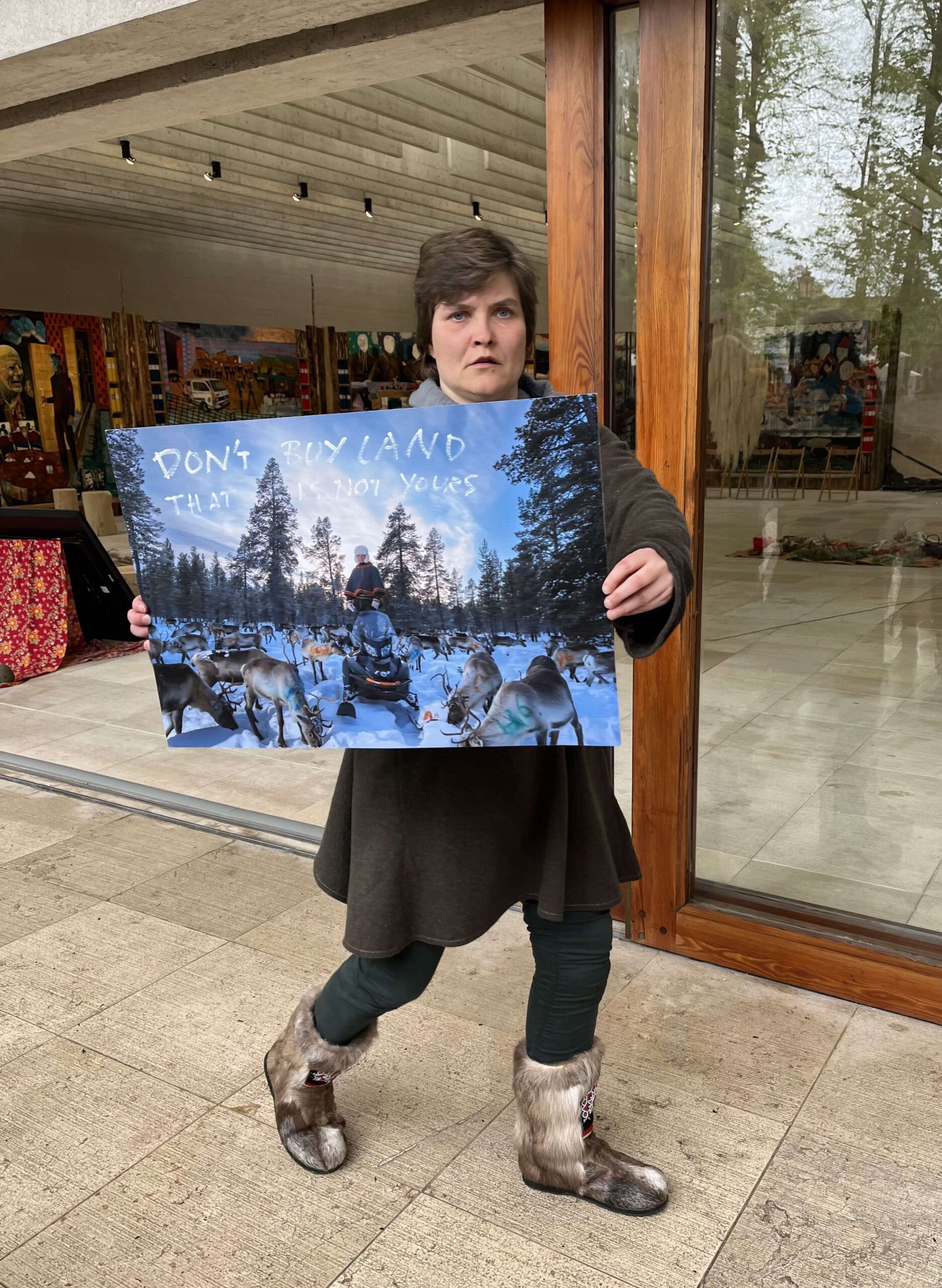The Sámi cultural resurgence and The looming end of climate nihilism
I arrive to Venice by train. It’s April 2022 and I’m in the city to attend the pre-opening days of the Venice Biennale. On the gorgeous train ride from Münich to Venice I saw a man flipping through a stack of printed papers. They were articles titled “10 things not to miss at the Venice Biennale” and “THE pavillion not to miss: Venice Biennale Guide”. I ask the man to have a look through the pile and I was reminded about one of the most exciting events of the biennale. The fact that the Nordic Pavillion, usually the pavillion of the Swedish, Norweigan and Finnish nation states, has been temporaily renamned to the Sámi pavillion. Hosting three Sámi artists from the respective nation states.
The main comissioner for the pavillion, ‘The Office of Contemporary Art Norway’s director Katya García-Antón made the following statement reagrding the move: “The global pandemic, the impact of climate change, and worldwide calls for decolonization are leading us all to focus on alternative possibilities for our future and that of our planet. At this pivotal moment, it is vital to consider Indigenous ways of relating to the environment and to each other.” The pavillion hosted artists Anders Sunna, Máret Ánne Sara and Pauliina Feodoroff. This text will focus on the performance Matriarchy by Pauliina Feodoroff and use it as a spring board for thinking about the role of art and the conflict between indigenous and industrial cosmologies in the era of the climate crisis.
The Sámi – blood, erasure, resurgance, Venice
A quick note for those outside the know. The Sámi are an indigenous people of the Fennoscandinavian peninsula who belong to a large piece of land called Sápmi. This land stretches through vast parts of the nation-states of Sweden, Norway, Finland and a piece of northwestern Russia. The history of the Sámi ressembles that of many other indigenous peoples of the western world. For millenia the people lived in a close kinship with the land, living of fishing, hunting, farming, trading and reindeer herding, a way of life one can easily call sustainable. During the proper establishment of the Swedish and Danish-Norweigan nation states in the 1500-1600s Sápmi became a target. A centuries long process of colonisation started when farmers from the south were granted tax exemptions to settle in Sápmi. Over the years the Sámi homeland was slowly carved up and the people either pushed away to the mounatins, into forced or low-wage labour or into assimilation. This opression culminated in the early 1900s with the boarding school practice and the subsequent cultural-linguistic erasure. All Sámi children were to be taken to schools to study in the same manner as the rest of the children in the respective nation states.
In these boarding schools the Sámi language was forbidden, children were beaten for speaking it, and were taught to adore a ‘scandinavian’ way of life. Occassionally, the racial biological institute, a pre WW2 academic institution located in Lund and Uppsala, might come by and measure every inch of the childrens’ naked bodies, without consent. These schools and their ideologies led to an erasure of Sámi culture and language amongst the people themselves. Many Sámi abandoned their homes for southern cities, many that stayed in Sápmi abandoned their native language and sometimes also the way of life, assimilating into what had become the Fennoscandian nation-states. Today however, as indigenous movements are gaining momentum across the globe, there is a Sámi cultural and linguistic resurgence. More and more Sámi culture is spread throughout the mainstream and language programs are becoming increasingly popular, especially amongst the youth. Whilst there are still several political and cultural struggles, and gains, the forced assimilation has lost momentum. It is with this knowledge of the Sámi struggle that I wake-up and head to the opening of the Biennale.
Sámi presence – The City and The Pavillion
On my way to the inauguration of the Sámi Pavillion and the performance Matriarchy I walk through all of Venice. During this hour of walking unfamiliar streets, I start seeing very familiar symbols. The flag of Sápmi is hanging out of random hotel windows and between fancy-looking art workers and the service workers of the city, the Sámi people stand out. Many are wearing Gákti, a traditional and colourful piece of clothing, or Sámi jewlery or accessories. There is a palpable sense of pride over the representation at the biennale and the presence of the Sámi community is undeniable.

The performance Matriarchy starts with a kind of exposé. The six performers, all readable as women of varying generations, circle the outside of the Sámi pavillion presenting objects that are central to Sámi culture. Feodoroff argues that indigenous and colonising people have never greeted each other on equal terms, and proposes this kind of introduction of symbolic and practical objects as a greeting signed Sápmi. I see both confusion and recognition in the eyes of the art market audience as sweetgrass braids, lichen and fashionable fishing equipment is presented on this impromptu runway. It effectivley reverses the power dynamic that most likely was present when white settlers arrived to Sápmi for the first time, showing of their shovels, seeds and guns. Us spectators are soothed into the realm of Sápmi within these 15 minutes.
As we enter the actual pavillion we gather in a circle around what becomes a stage. It is backdropped by Anders Sunnas’ five large impressive paintings that depicts moments of oppression and harm done to his family, by the Swedish state, for the last five decades. Having lost access to large areas of both reindeer herding and hunting and fishing rights he rightfully depicts the workers at the swedish state as facist footmen. Next to the five large paintings framed by wooden panels; the sixth is burnt to the ground. With only ashes remaining in a pile on the floor. It is in front of this tableau that Matriarchy takes place.

Matriarchy
“Matriarchy, celebrates the decolonisation of the female body and its communion with the land. In our society everybody leads and nobody leads” says Feodoroff about the performance. In the beginning snippets of the second part we see the two contemporary dancers and twins Birit and Katja Haarla explore a rather queer spectrum of femininity. There’s the nature-loving butch with dirty working gloves and a love for proximity with the ground and the domme femme with skyhigh stilettos and seashell nails. These two figures dance together in a dialogue of contemporary dance where patriarchal expectations of who should lead are suspended. The two dancers seem to be proposing, listening, responding and hanging out together in a way that I read as void of hierarchy. This dialogue engages with both queer imagery and social ecologist notions of co-operation. I witness a dance that complexify majoritarian expectations and stereotypes toward Sámi women.
The performance continues with a joyous dance by the same two dancers. They now dance to music coming straigh out of Sápmi. They are jumping between each other holding colourful Sámi fabrics that flow and toss in a hypnotising manner. From my point of view gender is suspended to make way for celebratory dance. The two dancers are joined in this celebration by the performers from the earlier part of the piece. This time they’re waving long sticks with fabrics of different colours, hinting at traditions of resistance and protest. They engage in a choreography that ressembles demonstration and some sing along to the track. These images of indigenous resistance and celebration not only insists on a conscious relationship between political action and cultural liberation it also moves many in the room to tears, including myself. The palpable sense of pride I earlier saw glimpses of in the city is amplified by the end of the peforrmance as the majority of the audience are clearly Sámi. What I had the luck to witness felt like a notable moment for indigenous recognition within both the Nordic art scene and by way of the biennale, also the global.
I can’t help but adore the symbolic ambiguity of Anders Sunnas immolated painting. The ashes hold so much. They signify an ending, in this case an expression of anger or protest, a destructive force released after decades of oppression. But in the context of the forest, which is one of Sápmi’s most common landscapes, fires are both a destructive and rejuvenating force. Belonging to the natural life-cycles of forests they destroy and pave way for new life simultaneously. It is precisely here I find myself reading Matriarchy, between burning the oppressive past and bringing on a future full of life.
How Re/Production creates / Time as material relationships: One radical notion from indigenous cosmologies
A cultural movement that takes the artistic proposals and way of life of the Sámi as serious antidotes to the climate crisis, can not adhere to primitivsim. Often when discussing Indigenous or environmental struggles, a desire for regression into something pristine and untouched is expressed. When this expectation and desire is transposed to indigenous peoples and arts, it’s not only racist, it is also counterproductive. There is nothing ‘pure’ or ‘natural’ about indigenous lifestyles, one simple example being that the Sámi use drones and motorcycles to herd their reindeer. In the text bits that follow, I juxtapose indigenous and industrial cosmologies as a method for producing discourse. There is no person, indigenous or not, that exists fully in one cosmology or the other. We are all a patchwork of these worlds of thoughts and countless others.The flag of Sápmi is hanging out of random hotel windows and between fancy-looking art workers and the service workers of the city,

One main difference between indigenous and industrial societies is that the former has it’s material and cultural basis in the cycle of seasons and is, on a material level, in constant dialogue with nature. Whereas industrially founded cultures are detached from cycles, movements and rhythms of nature. Andreas Malm writes extensively about this detachment in his magnum opus Fossil Capital. In two fascinating sub-chapters titled ‘The advantage of coal in time/space’ he explains how the process of industrialisation and the adoption of fossil fuels created modes of production that are fundamentally separated from natural processes like sunrise, sunset and the flow of rivers. When the newborn cotton industry of England shifted from energy sources that fluctuate and pulsate, such as rivers, into energy sources that could be stocked into warehouses, such as coal, the curse of the nature-culture separation was born. This meant that large swathes of humanity, for the first time in history, could be reproduced without any direct, personal interaction with the more-than-human environment. The radicality in indigenous proposals lies exactly in the integrity of the entanglement between human culture and nature as a living pulsating network, rather than a resource to be extracted and exhausted.
Not only has Matriarchy been created from a material reality that lives in active relationship with nature, it is also insisting on social values that often follow that material reality. There is a spiritual, linguistic and cultural atunement to the landscapes of Sápmi that persists to this day. It persists because the people themselves see the value in carrying that legacy onwards: a pack of practices that include reproductive care, intergenerational respect, awareness and interaction with more-than-humans on a daily basis. It is precisely here that Matriarchy finds its strength. It’s a gentle yet forceful reminder to the spectators of what makes indigenous cosmologies different from the industrial ones’: The fundamental integration of nature in culture, and the reciprocity and care that follows. These conflicting cosmologies are addressed simply but profoundly when Matriarchy finishes with the statement “Don’t buy our land. Buy our art instead”. A statement that also helps us spectators consider our own position in relation to the Sámi struggle. It proposes an allyship that listens, watches and tends to Sámi artists and art works.

The Danish Pavillion neglecting the utopic science fiction of reality
To illustrate how the difference in cosmologies can play out in reality, let’s turn to Denmark. You may have seen pictures of Uffe Isolotto’s exhibition we walked the earth in the Danish Pavillion of the Biennale. Three hyperrealistic, white centaurs have died in a sort of futuristic stable. A hetererosxual centaur couple and their newborn live no more, the man has committed suicide by hanging and the woman lies dead in childbirth. Both the title and the thematic meditate on and further a dystopic and hopeless view of the future that, and here comes an opinion, doesn’t serve anyone. Anyone that watches the news knows that certain kinds of humans relationships to the environment has created a dire crisis affecting us all. Rising sea level, unpredictable weather, the sixth mass extinction, chaos and unproportionally distributed death and upheaval. We’re deeply enmeshed in the apocalypse and we all know it. Three dead centaurs can at best serve as a spooky reminder, and at worst do what I believe they do most. Reassure well-read art visitors of that their concern of the state of the planet is progressive and in line with global concerns. Also known as not changing or re-evaluating your position.
I do not believe that all art should be instrumental and serve a clean-cut purpose. Ambiguity is literally priceless. However, when Isolotto talks himself into the discourse of the climate crisis and other politically tumultous developments, I choose to read his work through that lens. In an interview with ArtReview he said: “The present time we live in is becoming increasingly complex and unpredictable as we face a lot of challenging realities, be it ecological, political or existential. There’s much hope and despair in the air, and I want to make that a physical reality with this installation.” It is precisley in that effort to talk about ‘our time’ that his lack of vision and desire for positive change stuns me. There is an acknowledgment of a permacrisis, yet no desire to alter it’s course. “we walked the earth” then joins the ranks of climate-related art works that lack vision. On the other side of the small gravel road however, stands the Sámi pavillon. There is about 40 meters between two buildings, but at this Biennale there is a cosmological rift separating the two. What Isolotto fails to attempt in terms of vision, Feodoroff’s performance Matriarchy is shivering of. The descriptive text says: “Matriarchy is a collective performance of healing and renewal, conceived as a process of rematriation to return to a world of kinship between people, land, waters, spirits, and other-than human beings.” The performance situates itself in its social and political reality. The damage that has been done to the Sámi needs to be healed, but there must also be renewal and return to landbased practices. An interesting proposal for futures that seek to integrate tradition into modernity. With it’s communal dances, songs, protests and showcasing of culture, Matriarchy succeeded in staking out that direction. It managed to remind me of the pain endured and gently grabbed my hand to whisper about a more caring, interconnected future to come. The tears that ran down my face as I witnessed this performance were both a compersive cry for the recognition of a community long-repressed, as it was a confused relief to witness a tender artistic project that articulates a desire for more sustainable futures. Matriarchy is a performance that consciously participate in the project to create the poetics of sustainability we all deserve.
